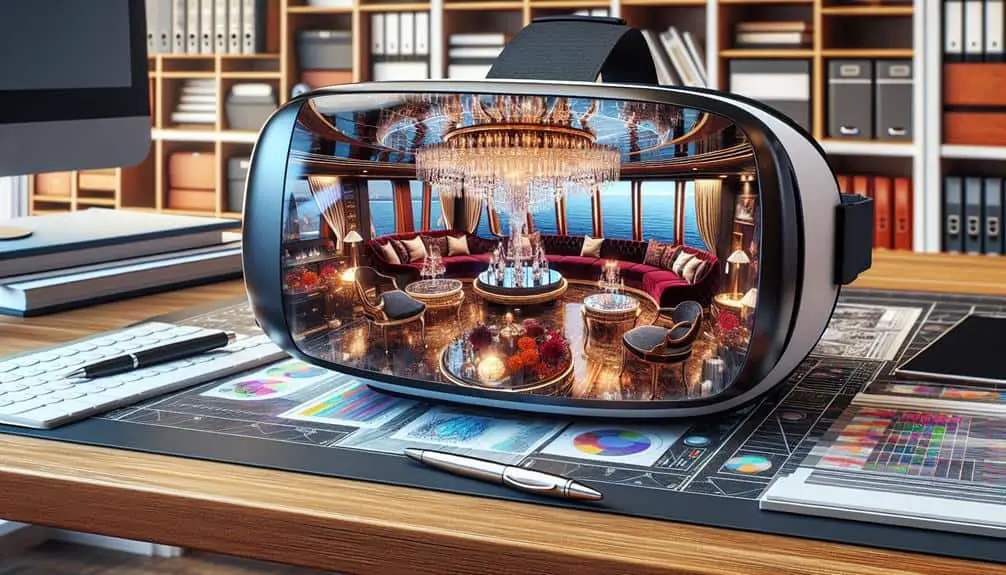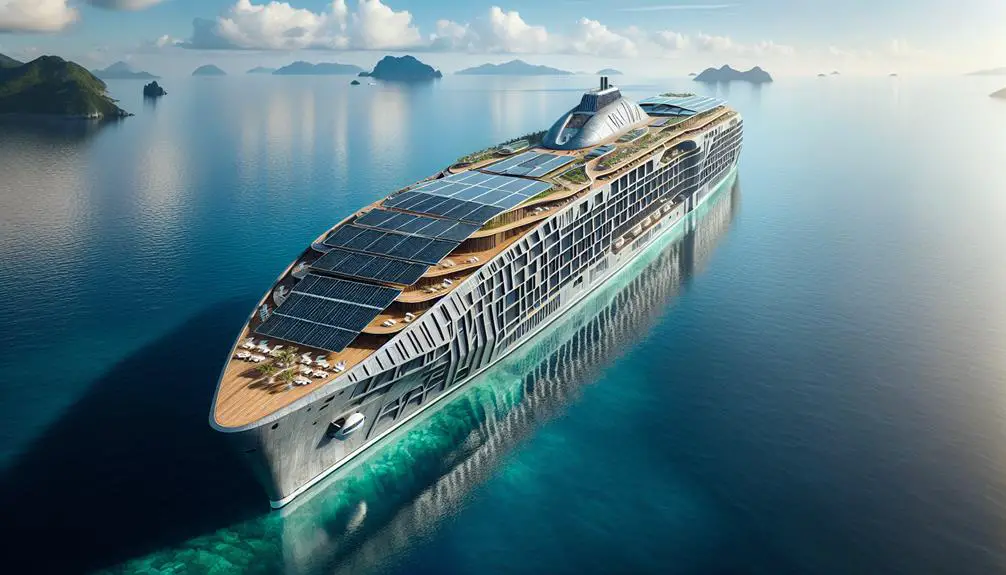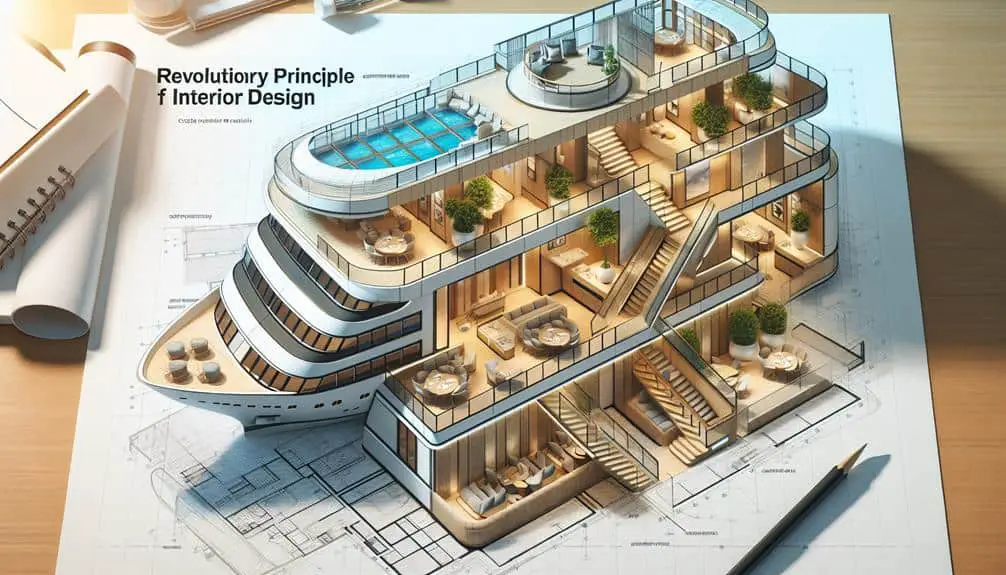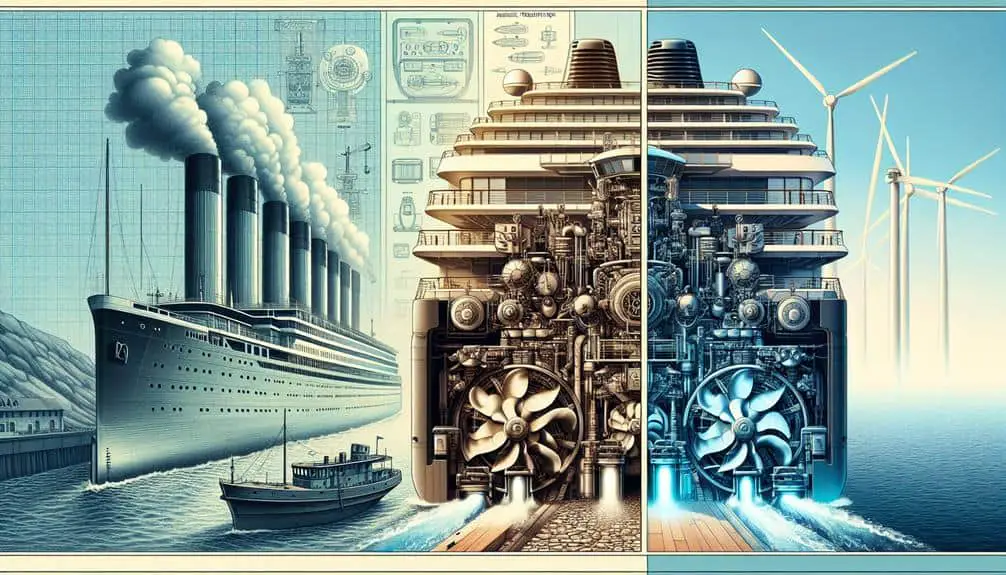Immerse yourself in the future of cruise ship design with Virtual Reality (VR). Sail through detailed simulations to visualize decks and cabins. Collaborate in shared virtual environments for precision design. Experience ship amenities and activities in immersive landscapes. Optimize the design process with real-time adjustments. Explore innovative trends in AR and MR for a deeper understanding. Preview entertainment venues virtually for efficient design. Dive deeper into the world of VR to elevate your cruise ship visualization capabilities.
Key Points
- Virtual reality enhances spatial understanding of ship designs.
- Real-time adjustments and collaboration streamline the design process.
- Immersive VR experiences revolutionize visualizing vessel concepts.
- Interactive simulations offer efficient design previews.
- AR and MR innovations deepen designers' insights for cruise ship visualization.
Evolution of Cruise Ship Design
In the evolution of cruise ship design, advancements in technology have played a pivotal role in shaping the modern maritime industry. The innovation in materials, propulsion systems, and navigation technology has revolutionized how cruise ships are built and operated. From the early days of wooden hulls and steam engines to the current era of state-of-the-art composite materials and advanced propulsion systems, the evolution of cruise ship design has been a journey marked by constant innovation.
The integration of new materials, such as lightweight composites and aluminum alloys, has allowed for the construction of larger and more fuel-efficient vessels. Innovations in propulsion systems, including the adoption of diesel-electric engines and azimuth thrusters, have enhanced maneuverability and reduced environmental impact. Additionally, advancements in navigation technology, such as GPS systems and dynamic positioning, have improved safety and operational efficiency on modern cruise ships.
Benefits of Virtual Reality Integration
Leverage virtual reality integration to enhance visualization for cruise ship design with unmatched precision and immersive detail. By incorporating immersive simulations, you can navigate through virtual decks, cabins, and public spaces, gaining a thorough understanding of spatial relationships and design elements. This level of immersion allows for a realistic evaluation of the vessel's layout, enabling designers to refine every aspect efficiently.
Moreover, virtual reality facilitates seamless design collaboration among stakeholders regardless of their physical location. Through shared virtual environments, teams can review, annotate, and modify ship designs in real-time. This fosters improved communication, accelerates decision-making processes, and ensures that all parties are aligned on the project vision.
The advantages of virtual reality integration extend beyond visualization, offering a platform where intricate details can be analyzed, modified, and perfected with utmost accuracy. Embrace this technology to elevate your cruise ship design process to new heights of precision and efficiency.
Enhancing Passenger Experience Through VR
Enhance the passenger experience onboard with Virtual Reality technology, revolutionizing how guests engage with cruise ship amenities and activities. By integrating Virtual Reality (VR) into the passenger experience, cruise lines can create immersive environments that transport guests to new worlds while onboard. Through VR headsets, passengers can explore virtual landscapes, partake in simulated activities like underwater adventures, or even engage in virtual tours of the ship's facilities before visiting them physically.
Passenger engagement is enhanced as guests interact with onboard attractions through VR, adding a layer of excitement and novelty to traditional cruise activities. Immersive environments created by VR technology provide an unparalleled level of immersion, making guests feel like they're part of a completely different setting while still onboard the ship.
Streamlining Design Process With Virtual Reality
Optimize the cruise ship design process by integrating Virtual Reality technology for streamlined visualization and planning. By leveraging Virtual Reality (VR) in ship design, you can greatly enhance design efficiency and create an immersive experience for stakeholders involved in the process.
Here's how VR can streamline the design process:
- 3D Visualization: VR allows you to view ship designs in a three-dimensional space, providing a more realistic understanding of the layout and structure.
- Interactive Planning: With VR, you can interact with the design elements, making real-time adjustments and modifications to optimize the layout efficiently.
- Collaborative Environment: VR enables multiple team members to engage simultaneously in the design process, fostering collaboration and enhancing decision-making.
- Efficient Feedback Loop: Through VR simulations, you can quickly gather feedback from stakeholders, iterate on designs promptly, and ensure design accuracy.
Integrating VR technology into cruise ship design not only improves the efficiency of the process but also delivers a more engaging and immersive experience for all involved parties.
Future Trends in Cruise Ship Visualization
To stay ahead in cruise ship design, explore upcoming advancements shaping the future of visualizing vessel concepts. Immersive experiences are set to revolutionize the way cruise ships are visualized and designed. Innovations in technology, such as augmented reality (AR) and mixed reality (MR), will offer designers and engineers the ability to step inside their creations before they're even built.
These immersive experiences will allow for a deeper understanding of spatial relationships, scale, and functionality, ultimately leading to more efficient and innovative designs. By utilizing innovative technology like real-time rendering and interactive simulations, designers can test different scenarios and make adjustments in a virtual environment, saving time and resources during the actual construction phase.
Moreover, future trends in cruise ship visualization will likely focus on enhancing user experiences through virtual tours and interactive walkthroughs. Passengers will be able to preview cabins, amenities, and entertainment venues in a realistic virtual setting, providing cruise lines with a powerful marketing tool to attract customers. Embracing these advancements will be essential for staying competitive in the ever-evolving cruise industry.
Frequently Asked Questions
How Does Virtual Reality Technology Impact the Environmental Sustainability of Cruise Ship Designs?
When evaluating the impact of virtual reality on cruise ship design environmental sustainability, you can identify efficiency gains, reduced energy consumption, and minimized waste. These sustainability benefits are essential for improving the industry's eco-footprint.
Can Virtual Reality Be Used to Simulate Emergency Evacuation Procedures on Cruise Ships?
In the domain of safety simulations, virtual reality shines for crew training in evacuation procedures. It immerses you in realistic emergency scenarios, enhancing preparedness like never before. Experience the precision of VR for safety mastery.
Are There Any Challenges or Limitations in Using Virtual Reality for Designing Cruise Ship Interiors?
When designing cruise ship interiors, challenges arise in virtual reality implementation. Limitations in detail accuracy and spatial perception may hinder adoption. Overcoming these obstacles demands advanced VR technology to guarantee precise design visualization.
How Does Virtual Reality Integration Affect the Cost and Timeline of Building a Cruise Ship?
Incorporating virtual reality into cruise ship design enhances cost efficiency by streamlining planning and decision-making processes. It optimizes the construction timeline by allowing detailed visualization and adjustments before physical work, reducing errors and delays.
Is There a Potential for Virtual Reality to Revolutionize the Way Cruise Ship Operators Train Their Staff Members?
Immersive virtual reality for staff training can revolutionize cruise ship operations. Enhanced simulations create realistic scenarios, improving skills and customer experience. Embrace this transformative tool to elevate service standards and navigate the seas of excellence.




